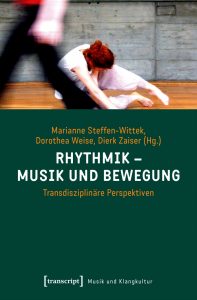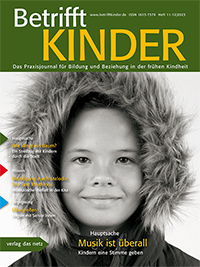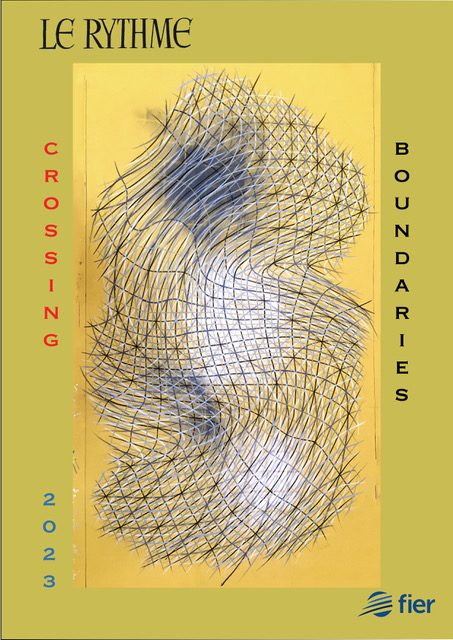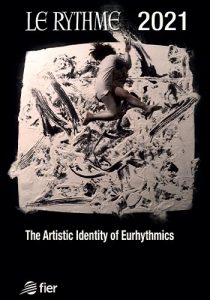Books
Spot 5: Anamnesis. Bewegungsimprovisation mit Objekten in der Rhythmik-Praxis mit älteren Menschen.
Spot 11: Neue Musik mit Kindern
In: Marianne Steffen-Wittek/Dorothea Weise/Dierk Zaiser (Eds.), Rhythmik – Musik und Bewegung. Bielefeld: transcript Verlag, 2019
https://doi.org/10.14361/9783839443712-015

Journals
Co-editor of the special Issue of Music Education Journal (Issue 34-35, 2024/2025)
Greek Society for Music Education (G.S.M.E.)

Musik ist überall. Kindern eine Stimme geben
In: Betrifft Kinder 11-12/2023
Wie ist es, wenn jeden Tag musiziert wird? Bleibt der Zauber der Musik erhalten? Die Pädagog:innen des MusikKinderGartens Weimar berichten aus 20 Jahren Erfahrung.

unfolding walking stories
In: Le Rythme 2023 “Crossing Boundaries”
In this article, I present the ways in which a Eurhythmics lesson with seniors crosses the borders of a conventional class and affects participants’ everyday life by improving the movement of their bodies. The physical action of everyday movements belongs to the area of procedural memory. It can be characterised as a series of automatic movements and well-established habits. But habits also pose limitations; they keep following pre-formed paths that cannot be undone and reforged without some effort. This also inevitably leads to an age-related deterioration of the quality of movement, as the elderly seldom face new movement challenges. I present how seniors can increase perception of their bodies when performing their everyday rituals through taking part in a eurhythmics performance. Moving between pedagogical processes and philosophical perspectives, I focus on how a Eurhythmics class can cross the confines of a body’s limitations and change the perception of the body in seniors, thus reforming and improving their everyday movements as well their body memory.

Pnoe, the Performing Body in a Synthesis of Music and Movement
In: Le Rythme 2021 “The Artistic Identity of Eurhythmics”
In performance art the body is used as a multifaceted medium; it interacts with the audience, it reflects social, cultural and political realities, it emits meanings and takes on different interpretations, it explores individual identities and traces back roots. This article explores the different aspects of the body in performance art and connect them with the body in eurhythmics. The article is based on a performance called Pnoe. The performance focuses on the body as the primary medium of the interaction between music and movement and presents the creation process inside a synthesis of music and movement.

Corona-virus: Creativity in the midst of limitations!
Co-Authors: Vasiliki Aintzi, Katerina Kouthouri, Clio Papadia,
In: Music Education Journal (Issue 30), Greek Society for Music Education (G.S.M.E.)
The new Covid-19 restrictions affecting societies globally have created the need to adapt our teaching practices (and our lives in general). Music educators act in accordance with the human behaviors and the society’s trends and also, base their lessons on the interaction between the teacher and the students principles that now need to re-adjust. Some practical examples of changes imposed by this new reality include: the use of masks during singing lessons, the complete prohibition in the use of wind instruments in the classroom, the use of movement activities while keeping a safe distance from peers, teaching in open-air areas and instrumental teaching practices for either online or in-class lessons. This article aims to present creative ideas on how to adapt music lessons according to the new Covid-19 restrictions.
The wonderful dialogue between music and movement
In: Music Education Journal (Issue 29), Greek Society for Music Education (G.S.M.E.)
“All musical truth resides in the body” said Émile Jaques-Dalcroze, and since has opened the way for the great dialogue between music and movement. In a dialogue the body participates with gestures, expressions, movements; the pace of conversation changes and is distributed differently between the speakers; the sound of the voice changes according to the subject, the situation and through this process we learn something new. The article explores the relationship between music and movement, refers to issues related to their interaction, all this through a kinesthetic perspective. Four different examples of activities are intended to support the interaction of music with movement and to present the vast possibilities of interaction between them.
Intercultural education through vocal improvisation
In: Music Education Journal (Issue 27), Greek Society for Music Education (G.S.M.E.)
Music, apart from being a key feature of cultural education, is also a creative way of acquiring knowledge and skills through a wide range of methodological approaches. This explains its importance in intercultural education, where it plays a central role. In a multicultural society, where different kinds of cultures, languages and values coexist, we must find ways to support not only the relationship between them but also their interaction, in order to encourage the artistic heterogeneity and diversity and to give each child the opportunity to express themselves. The current article presents some examples of educational material based on vocal improvisation, which focuses on acquiring and integrating the element of language into the music lesson. This can be achieved by: a) voice and language experiments and improvisations, b) different music notations, c) inclusion of the language of the region of origin, d) musical-cultural specifics of the characteristics of origin (rhythmic patterns, scales, musical forms genres, dances etc.). Additional aims of that kind of educational approach is to strengthen children’s critical thinking, to promote the cultural participation and integration of every child, and to use the voice and language creatively in their development.
Introduction to the music and movement with old people
In: Music Education Journal (25) Greek Society for Music Education (G.S.M.E.)

People of all ages can learn and play music with their bodies, their voices and musical instruments (mainly percussion), regardless of whether they had or not some prior musical education or experience. The context, music and movement plays the most important role: it enhances sound perception, it enables the participants to connect with different and unfamiliar musical elements and types while improving at the same time their physical and cognitive abilities and their aesthetic judgement. The music lesson with old people includes activities for the awareness, motivation and perception of body and movement, offers a musical repertoire of different eras and genres, different styles of music notation, improvisation with voice, musical instruments and movement. This article presents also an example of a music lesson with old people based on contemporary music and improvisation.
The dream eater – A musical-pedagogical performance for children (ages 7- 11)
Co-Authors: Maria Yerosimou, Clio Papadia, Gloria-Maria Androulaki
In: Music Education Journal (22) Greek Society for Music Education (G.S.M.E.)
In the current article we present a proposal for the creation of a musical- pedagogical performance based on the Michael Ende’s fairytale “The dream eater”, for children aged between 7-11 years old. The following proposal may be useful for musicians, educators or musical-pedagogical groups that are interested in presenting interactive performances for children.
The war of the lost slipper, a musical-pedagogical performance for children (ages 8-11)
Co-Authors: Maria Yerosimou, Clio Papadia, Gloria-Maria Androulaki
In: Music Education Journal (18) Greek Society for Music Education (G.S.M.E.)
In the present article we will share our experience regarding the creation of an interactive musical-pedagogical performance. This task was rather complex as we aimed to combine music and artistic-drama elements with musical pedagogical activities through interactive participation of the audience (children). We shall present you the course of our work from the birth of the initial idea till the implementation of our project.